
Rhodolite Garnet Gem: Agyapadeɛ, Nkyerɛaseɛ & Boɔ Akwankyerɛ
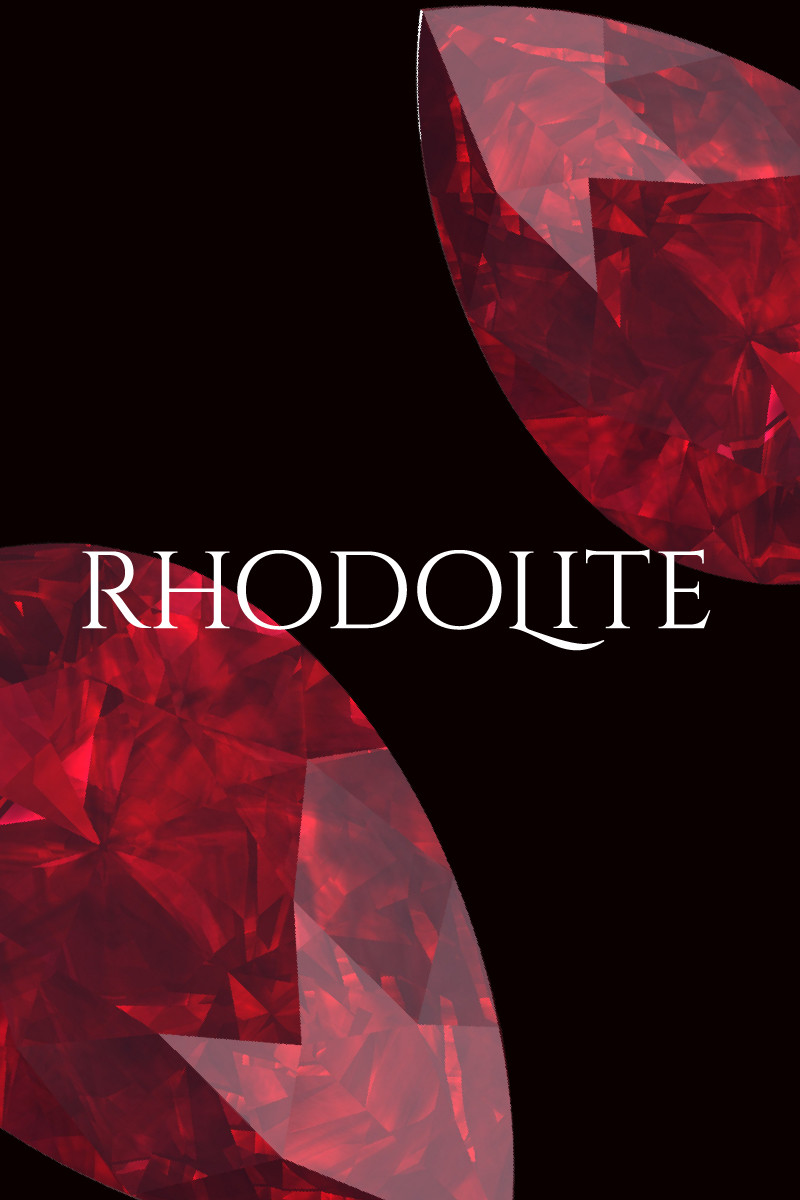 Rhodolite yɛ aboɔden abo a wɔfrɛ no garnet a ɛyɛ pink kosi kɔkɔɔ-akutu. So rhodolite garnet yɛ abɔde mu ɔbo? Ɛyɛ! Rhodolite kɔla fɛfɛ no, sɛ́ ɛyɛ raspberry, plum, anaa bobesa no, nyinaa yɛ nea abɔde na ɛbɔe.
Rhodolite yɛ aboɔden abo a wɔfrɛ no garnet a ɛyɛ pink kosi kɔkɔɔ-akutu. So rhodolite garnet yɛ abɔde mu ɔbo? Ɛyɛ! Rhodolite kɔla fɛfɛ no, sɛ́ ɛyɛ raspberry, plum, anaa bobesa no, nyinaa yɛ nea abɔde na ɛbɔe.
Wɔ garnet mu no, rhodolite da nsow esiane ne kɔla a ɛyɛ hare, ɛyɛ kɔkɔɔ kɛse ne ne fibea ahorow a ɛtrɛw nti. Wɔ aboɔden abo mu no, rhodolite da nsow wɔ ne refractive index a ɛkorɔn — a ɛkyerɛ sɛ ɛhyerɛn a ɛyɛ nwonwa — ne kɔla ahorow a ɛyɛ fɛ, a ɛyɛ ɔdɔ ho.
Nanso so rhodolite garnet yɛ ɔbo pa? Yɛbɛka saa, nanso wobɛtumi aka ama w’ankasa wo ho wɔ akwankyerɛ yi awieeɛ.
Ɛnnɛ, yɛbɛkɔ rhodolite garnet ahoɔden, ayaresa tumi, abakɔsɛm, ne bo, ne nea ɛkeka ho nyinaa so.
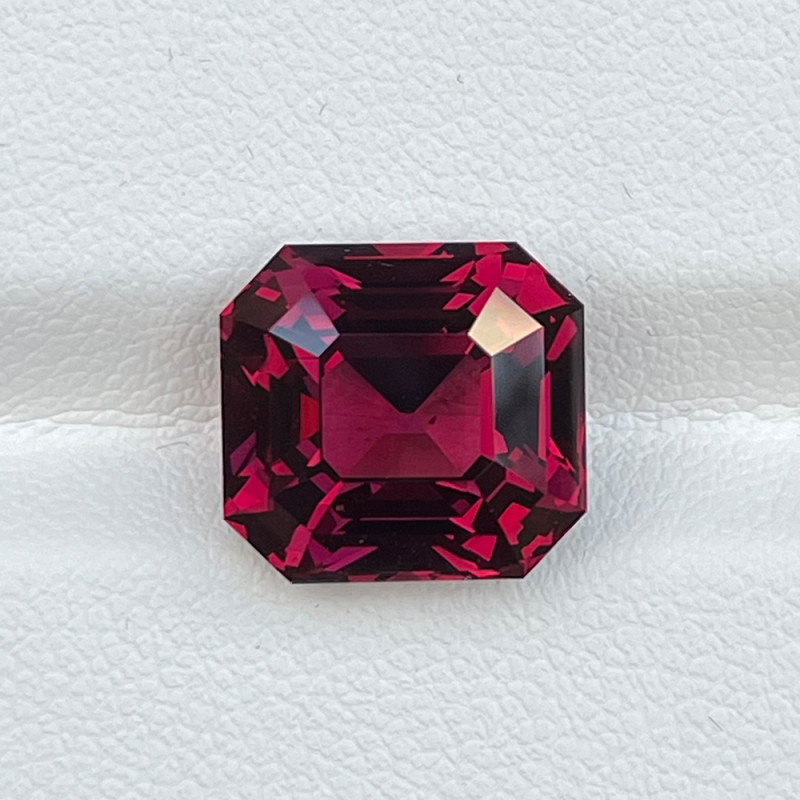
Ɛfa Rhodolite Garnet Abo ho
Rhodolite garnet yɛ aboɔden abo a ɛsom bo fã bi , ɛwom sɛ ɛtaa te sɛ aboɔden abo a ɛsom bo a wɔfrɛ no ruby de . Nokwarem no, abodin ahorow a wɔde frɛ rhodolite no bi ne:
Arizona Ruby na ɔkyerɛwee
Montana Ruby na ɔkyerɛwee
New Mexico Ruby a wɔfrɛ no Ruby
Nokwarem no, rhodolite ne ruby yɛ abo ahorow.
Nsonsonoe titiriw a ɛda rhodolite garnet ne ruby ntam ne sɛnea wɔahyehyɛ, sɛnea ɛyɛ den, ne bo, ne nea ɛntaa nsi. Ruby yɛ corundum aboɔden abo a ɛwɔ 9 wɔ Mohs mineral hardness scale , a ɛkorɔn sen rhodolite. Ruby nso ho yɛ na na ne bo yɛ den sen rhodolite.
Esiane sɛ rhodolite bo nyɛ den nti, ɛyɛ ade a ne bo nyɛ den a wɔde besi ruby ananmu sɛ July awobo a wɔde di dwuma wɔ amanne kwan so no . Ankorankoro, rhodolite yɛ January awobo , Capricorn anaa Aquarius, zodiac ɔbo , ne 2nd ayeforohyia afeda abohene, te sɛ garnets nyinaa.
Ɛdefa nneɛma a wɔtaa de frafra ho no, wɔtaa de rhodolite frafra rhodonite . Rhodonite yɛ manganese inosilicate aboɔden abo a ɛnyɛ hann a ɛyɛ kɔkɔɔ a ɛte sɛ rose a wɔtaa hu a ntini anaa nsensanee tuntum kosi bruu wom.
 Mfonini a ɛwɔ atifi hɔ no: Rhodolite garnet asomuade kɔkɔɔ a ɛwɔ afã horow
Mfonini a ɛwɔ atifi hɔ no: Rhodolite garnet asomuade kɔkɔɔ a ɛwɔ afã horow
Rhodolite Nkyerɛkyerɛmu & Su ahorow
Garnet mineral kuw no wɔ abusua dua a ɛyɛ den. Nneɛma atitiriw a ɛtoatoa so ne pyralspite — pyrope , almandine , ne spessartite — ne ugrandite — uvarovite , grossular , ne andradite . Nnomaa ahorow biara wɔ n’ankasa ahorow, ɛwom sɛ ahorow pii yɛ nea wɔde afrafra de.
Rhodolite yɛ pyrope ne almandine afrafra, na ɛno ma wɔde abodin “pyrandine” frɛ no. Ɔbo no nsusuwii ne (Fe,Mg)3Al2Si3O12.
Sɛnea wɔtaa yɛ no, na wogye di sɛ rhodolite yɛ almandine fã 1 na pyrope fã 2. Nnɛyi aboɔden abo ho adesua fibea ahorow kyerɛw nsusuwii no sɛ almandine afã 3 ne pyrope afã 7.
Ne nyinaa mu no, mmoa ahorow afoforo te sɛ spessartite ne grossular kakraa bi abu so wɔ rhodolites mu, na pyrope-almandine nsusuwii betumi ayɛ soronko wɔ rhodolites ahorow mu.
Ebia wubetumi de magnet ahu nsonsonoe a ɛda rhodolite ne aboɔden abo a ɛte sɛ nea ɛte saa ara ntam, efisɛ rhodolite garnet yɛ magnetic a emu yɛ den kosi denneennen.
Rhodolite su a aka no ni:
Mohs denden : 7-7.5
Kɔla : Nneɛma a ɛyɛ hann kosi tuntum a ɛda pink, kɔkɔɔ, ne kɔkɔɔ ntam a lavender pink, raspberry, kɔkɔɔ, kɔkɔɔ-violet, kɔkɔɔ-kɔkɔɔ, kɔkɔɔ-kɔkɔɔ, violet, kɔkɔɔ ka ho
Ahwehwɛ nhyehyɛe : Cubic/isometric
Luster : Vitreous (ahwehwɛ) .
Transparency : Ɛyɛ nea ɛda adi pefee kosi nea ɛda adi pefee
Refractive index : 1.745-1.795 (Nneɛma ahorow bi gu ahorow sɛnea fibea te; Tanzania = 1.745-1.760; North Carolina, U.S.A. = 1.760-1.761; Zimbabwe = 1.750-1.760)
Density : 3.74-3.94 (Ɛsono mmeae bi wɔ baabi a efi; Tanzania = 3.79-3.80; North Carolina, USA = 3.84-3.89; Zimbabwe = 3.83-3.89)
Cleavage : Biara nni hɔ; Ɛtɔ mmere bi a, mpaapaemu a emu nna hɔ
Akisikuru : Conchoidal
Streak : Ɛyɛ fitaa
Luminescence : Biara nni hɔ
Pleochroism : Biara nni hɔ
Nsunsuanso a efi aniwa so : Ɛntaa mma sɛ nsoromma mu hwɛ; Ɛntaa mma sɛ ɛsakra kɔla
Ntrɛwmu : 0.026
Ɛwom sɛ rhodolite yɛ nea egu ahorow wɔ n’ankasa mu de, nanso ɛwɔ nketewa bi nso.
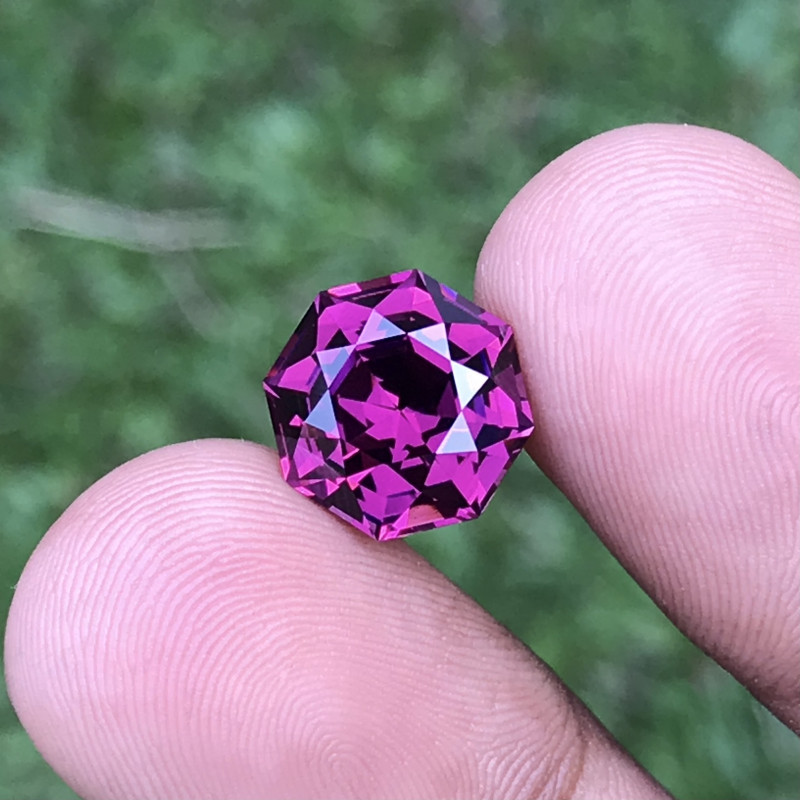 Mfonini a ɛwɔ atifi hɔ no: Bobe garnet
Mfonini a ɛwɔ atifi hɔ no: Bobe garnet
Rhodolite Ahorow Ahorow
Rhodolite subtype a edi kan ne grape garnet , a ɛwɔ kɔla kɔkɔɔ a emu dɔ a efi dade ne magnesium kakraa bi mu.
Afei, yɛwɔ Umbalite garnet .
Umbalite garnet a wonya fi Umba Asubɔnten Bon mu wɔ Tanzania no yɛ rhodolite a ɛyɛ pink-kɔla, kɔkɔɔ-pink, anaa kɔkɔɔ-kɔla a ne kɔla yɛ hyew sen rhodolite dodow no ara. Ebinom frɛ saa subtype a ɛkorɔn yi sɛ “Rodolite Hene.”
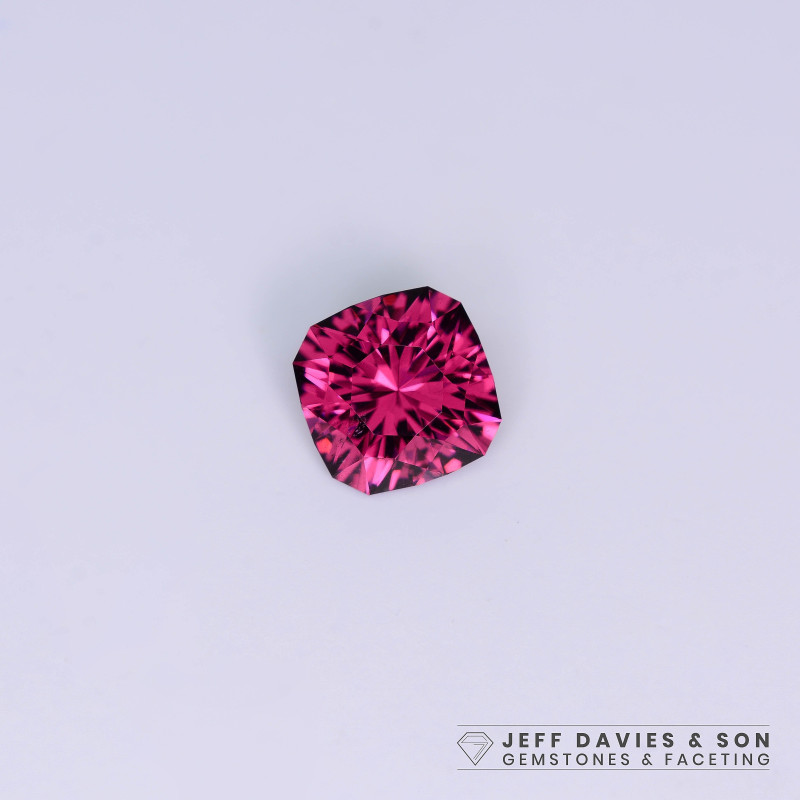 Mfonini a ɛwɔ atifi hɔ no: Umbalite garnet
Mfonini a ɛwɔ atifi hɔ no: Umbalite garnet
Sɛ yɛkɔ optical-effect subtypes mu a, momma yɛmfa rhodolite a ɛsakra kɔla mfi ase .
Garnet pii betumi ayɛ nea ɛsakra kɔla , a rhodolite ka ho. Rhodolites a ɛsakra kɔla no da adi bruu wɔ awia hann mu na ɛyɛ kɔkɔɔ-kɔla wɔ kanea a ɛyɛ hyew ase.
Nea etwa to no, yɛwɔ nsoromma rhodolite garnet .
Saa subtype yi da asterism adi, a ɛyɛ optical effect a wubehu hann a ɛyɛ multi-rayed reflection wɔ soro, na ɛma nsoromma nsɛso ba. Ebia nsoromma no wɔ hann 4 anaa 6, na nhwɛsode ahorow bi kyerɛ hann a ɛyɛ 4 ne 6 nyinaa fi mmeae ahorow. Nanso, nsoromma mu hwɛ ho yɛ na mma rhodolites.
 Mfonini a ɛwɔ atifi hɔ no: Rhodolite garnet a wɔasen wɔ Chinafo ɔtweaseɛ mu
Mfonini a ɛwɔ atifi hɔ no: Rhodolite garnet a wɔasen wɔ Chinafo ɔtweaseɛ mu
Rhodolite Garnet Nkyerɛase & Abakɔsɛm
Rhodolite yɛ ɔdɔ, tema, ne ayamye ho sɛnkyerɛnne. Sɛ́ afeda a ɛto so abien abohene no, saa garnet yi gyina hɔ ma ɔdɔ ogyaframa a enwu da ma awarefo.
Ebia wunim sɛ garnet yɛ aboɔden abo a edi kan a wonim no mu biako, na efi mfehaha pii ni. Saa abakɔsɛm dodow no ama wɔanya nkyerɛase pii wɔ rhodolite garnet honhom fam ntease ho.
Wɔ abakɔsɛm mu no, na garnets gyina hɔ ma hann (honhom fam ne ankasa nyinaa), nkwa, ne ahobammɔ. Ɛnnɛ, rhodolite kura ntease a ɛte saa ara, na egyina hɔ ma adamfofa, ahofama, ne akɔnnɔ.
Abakɔsɛm
Rhodolite yɛ nnɛyi ade a wɔahu kɛse. Amerikani aboɔden abo ho ɔbenfo William Earl Hidden dii kan tee garnet foforo ho asɛm wɔ North Carolina, U.S.A., fii amanneɛbɔ ahorow a ɛhɔnom aboɔden abo ho ɔbenfo A. M. Field de mae wɔ 1893 ne 1897 mu no mu.
Field gye dii sɛ abo no yɛ almandine ahorow. Hidden ne ne yɔnko dwumayɛni Oduruyɛfo J. H. Pratt yɛɛ abo no mu nhwehwɛmu na wotintim nea wohui wɔ 1898 mu, na wɔde edin “rhodolite” ho nyansahyɛ mae na wosii so dua sɛ nea wɔahyehyɛ no yɛ pyrope ne almandine afrafra mmom.
Ɛbɛyɛ sɛ Rhodolite din no fi Hela rhodon , a ɛkyerɛ “rose” anaa “rose-kɔla.” Ebinom ka sɛ edin no fi nhwiren a wɔfrɛ no rhododendron a ne kɔla te sɛ rhodolite no mu mmom.
Ɛho hia sɛ yɛhyɛ no nsow sɛ asɛmfua “rhodolite” nyɛ aban din a wɔde frɛ aboɔden abo. Mmom no, ɛyɛ aguadi din a agye din a abata ho de atɔn pyrope-almandine garnets.
Rhodolite Ahorow a Wɔahu
Wɔ 1978 mu no, Tanzania a wotu fam no dii kan huu Umbalite garnet wɔ Umba Asubɔnten Bon mu.
Wosusuwii sɛ garnet a ɛsakra kɔla a wohuu wɔ Tanzania Morogoro mantam mu wɔ 1988 mu no yɛ rhodolites mfe pii, nanso akyiri yi nhwehwɛmu daa no adi sɛ na ɛyɛ pyrope ne spessartite afrafra ankasa.
Sɛ yɛsakra fi abakɔsɛm so kɔ ayaresa so a, dɛn na rhodolite ye ma?
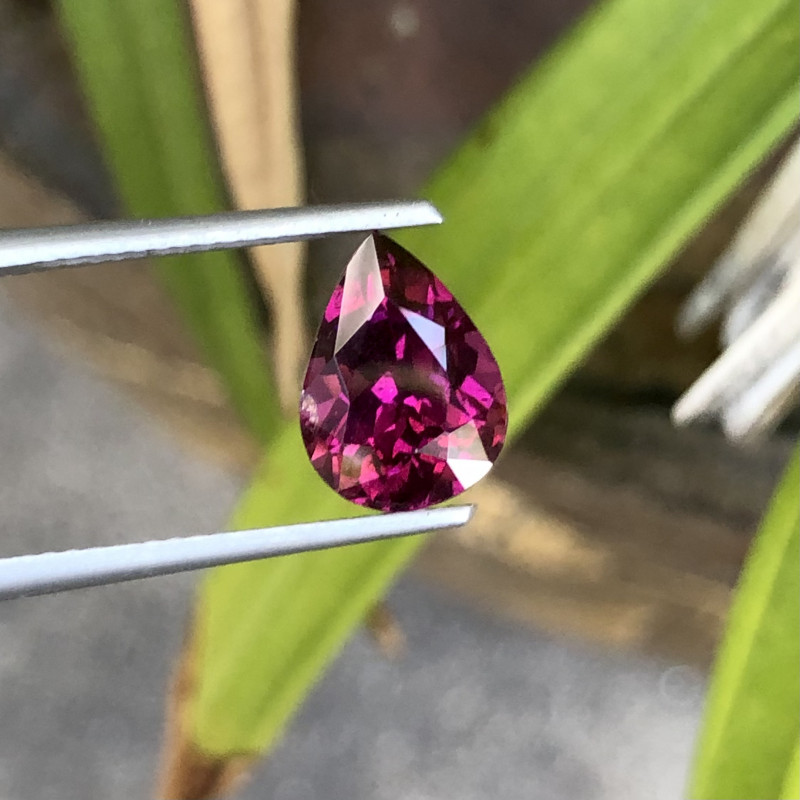 Mfonini a ɛwɔ atifi hɔ no: Rhodolite garnet a ɛwɔ afã horow a ɛte sɛ pear
Mfonini a ɛwɔ atifi hɔ no: Rhodolite garnet a ɛwɔ afã horow a ɛte sɛ pear
Rhodolite Ayaresa Nneɛma
Te sɛ ahwehwɛ nyinaa no, rhodolite betumi ayɛ adwuma sɛ ɔbo a ɛsa yare .
Rhodolite kɔkɔɔ, te sɛ aboɔden abo kɔkɔɔ afoforo , ma ahoɔden, anigye, ne akokoduru nya nkɔso. Rhodolites a ɛyɛ kɔkɔɔ te sɛ bobe garnet ka aboɔden abo a ɛyɛ kɔkɔɔ afoforo ho ma wɔhyɛ honhom fam nyansa ne wɔn ho a wohu. Saa bere yi nyinaa, abo a ɛyɛ pink te sɛ raspberry rhodolite hyɛ ɔdɔ a enni ano ma wo ho ne afoforo ho nkuran.
Nipadua mu Ayaresa
Crystal ayaresafo kamfo rhodolite kyerɛ sɛ wɔmfa sa:
Koma mu haw ahorow
Ahurututu mu haw ahorow
Mogya a ɛtɔ gu nipadua no mu
Hip nsɛm a ɛfa ho
Mogya a ɛnkɔ yiye
Nkate mu Ayaresa
Wɔ nkate fam no, rhodolite ɔbo no so ba obiara a wafa ahodwiriw mu no so mfaso. Wɔkyerɛ sɛ ɛboa wo ma wosa yare fi afobu, nkae bɔne, ne wo ho adwenem naayɛ mu.
Wɔ wɔn a wɔwɔ abusuabɔ mu no, wogye di sɛ rhodolite ma abusuabɔ a emu yɛ den yɛ kɛse, ɛma ɔdɔ no yɛ kɛse, na esiw abufuw anaa ahoɔyaw ano.
Chakra Ayaresa
Rhodolite yɛ chakra ɔbo a wɔde yɛ ntini, koma, ne abotiri chakra ahorow. Ɛdenam chakra abiɛsa yi a ɛma ɛyɛ pɛ so no, rhodolite de pintinnyɛ, nkate mu nimdeɛ, ne honhom mu foro a wɔaka abom brɛ wo.
 Mfonini a ɛwɔ atifi hɔ no: Rhodolite garnet a ɛyɛ kɔkɔɔ a ɛwɔ afã horow
Mfonini a ɛwɔ atifi hɔ no: Rhodolite garnet a ɛyɛ kɔkɔɔ a ɛwɔ afã horow
Rhodolite Aboɔden Aboɔ Nneɛma a Ɛwɔ Hɔ
rhodolite bo a ɛsom no gyina ne kɔla, ne twitwa, sɛnea emu da hɔ, ne ne mu duru a ɛyɛ carat so. Yɛbɛka ayaresa ne nnuru a wɔde yɛ nneɛma nso ho asɛm.
Ahosuo
Rhodolite garnet kɔla fi pink kosi kɔkɔɔ kosi kɔkɔɔ, na ɛwɔ ntam, na ɛma wosusuw sɛ wɔde toto amethyst ne ruby ho.
Mpɛn pii no, Rhodolite kɔkɔɔ no yɛ hare sen garnet afoforo a ɛyɛ tuntum dodo. Nanso, wonim no yiye sɛ ɛwɔ kɔla ahorow a ɛyɛ raspberry ne purplish-red.
Wɔ bobe garnet fam no, kɔla kɔkɔɔ a ɛho tew som bo sen kɔla kɔkɔɔ.
Efĩ afoforo a ebetumi aka rhodolite kɔla ne vanadium ne chromium. Spessartite dodow a ɛkɔ soro wɔ nea wɔde ayɛ no mu no betumi ama kɔla no ayɛ hare. Ɔhyew a ano yɛ den nso betumi asesa kɔla no, nanso yɛbɛka saa asɛm no ho asɛm kɛse wɔ Ayaresa ɔfã no mu.
Twa
Rhodolites dodow no ara a ɛwɔ agude gua so no yɛ faceted , a ɛboa ma wɔn hyerɛn a ɛkyɛn so (a wɔfrɛ no brilliance) no da adi. Nsusuwii kurukuruwa, pear, ne oval na abu so kɛse, nanso wubehu nso sɛ wɔatwitwa nneɛma ahorow a ɛyɛ fɛ te sɛ StarBriteTM a wɔatwa anaa “Rhodolite Rose” a wɔatwa.
Ebia wɔn a wɔyɛ agude nso betwitwa rhodolites ayɛ no cabochons . Ɛsɛ sɛ wotwitwa nhwɛsode ahorow a ɛda nsoromma mu hwɛ adi sɛ cabochons na ama wɔada nkɛntɛnso no adi yiye. Wobetumi atwitwa Rhodolites ayɛ no nwene anaa nhwiren nso.
 Mfonini a ɛwɔ atifi hɔ no: Rhodolite garnet ring a wɔde accent diamonds ayɛ
Mfonini a ɛwɔ atifi hɔ no: Rhodolite garnet ring a wɔde accent diamonds ayɛ
Ɛda adi pefee
Mpɛn pii no, Rhodolites wɔ pefeeyɛ kɛse, a Type II kɔla aboɔden abo a emu da hɔ grade , a ɛkyerɛ sɛ kakraa bi anaasɛ aniwa a ɛda hɔ ka ho a wotumi hu biara. Wɔ magnification ase no, wubehu ahwehwɛ nketenkete a wɔde aka ho wɔ rhodolites pii mu.
Nneɛma pɔtee a ebetumi de aka ho ne:
Rutile ahwehwɛ a ɛte sɛ nnade
Apatite anaa zircon ahwehwɛ a ɛnyɛ pɛpɛɛpɛ na ɛyɛ kurukuruwa
Zircon ahwehwɛ a nkekae “halos” wom .
Nneɛma bi a wɔde ka ho no ma wonya aniwa so nkɛntɛnso, te sɛ rutile a wɔde ka ho a ɛyɛ nhama a ɛwɔ nsoromma rhodolite nsoromma mu hwɛ akyi.
Carat Mu duru
Wobetumi ahu rhodolites akɛse, nanso ɛsono ne kɛse wɔ baabi a efi. North Carolina rhodolite aboɔden abo yɛ 1-2 carats pɛ, bere a Afrika rhodolite aboɔden abo betumi ayɛ 75+ carats.
Nsoromma rhodolite garnet a ɛso sen biara a wonim no yɛ cabochon a ne kɛse yɛ carat 15.6 a efi Kangala Mine, Tanzania. Rhodolites a ɛwɔ afã horow a ɛsõ sen biara no bi ne aboɔden abo a ne kɛse yɛ carat 86.4, a ɛno nso fi Tanzania.
Sɛ yɛhwɛ ɛka a, carat biara bo kɔ soro ma faceted rhodolites a ennu carat 1, efi carat 1-10, ne nea ɛboro carat 10.
Ayaresa ahorow
Wɔntaa nyɛ rhodolites ho adwuma yiye, nanso wɔayɛ nhwehwɛmu ahorow. Wɔ 1997 mu no, ɔhyew maa rhodolites yɛɛ bruu-kɔkɔɔ anaa borɔdɔma na ɛmaa dade bi kataa so. Sɔhwɛ foforo ada no adi sɛ sɛ wɔma rhodolites yɛ hyew kodu 600°C (1112°F) a, ɛma ɛsakra fi kɔkɔɔ so kɔ bruu (a ɛte sɛ hessonite) wɔ ɔkwan a wontumi nsakra so.
Ná wɔtɔn pyrope-almandine garnet a wɔayɛ no sɛnea ɛbɛyɛ a wɔde dade akata so no sɛ “Proteus garnets.” Wɔde Helafo po nyame, Proteus, a ɔsakra ne nsɛso din too wɔn din, efisɛ na ɛwɔ hann a ɛdannan mu a ɛyɛ tuntum, dade (a ɛte sɛ hematite) nanso na ɛyɛ kɔkɔɔ tuntum wɔ hann a wɔde fa nnipa mu.
Nneɛma a Wɔde Yɛ Nneɛma & Simulants
Wɔanam nsu mu hyew a enyin so ayɛ rhodolites a wɔayɛ de ayɛ nhwehwɛmu. Ebia ebinom bɛda wɔn ho adi wɔ aboɔden abo gua so, nanso eyi nyɛ nea ɛtaa ba.
Ebia wubehu rhodolite simulants —abo a ɛte sɛ nea ɛwɔ nnuru ahorow — a wɔtɔn sɛ “synthetic rhodolite.”
Nneɛma a wɔtaa de yɛ rhodolite ho mfonini ne cubic zirconia anaa ahwehwɛ a ɛwɔ kɔla ahorow.
Sɛ yɛsan kɔ abɔde mu a, ɔkwan bɛn so na rhodolite yɛ?
 Mfonini a ɛwɔ atifi hɔ no: Rhodolite garnet ahwehwɛ a ɛyɛ den
Mfonini a ɛwɔ atifi hɔ no: Rhodolite garnet ahwehwɛ a ɛyɛ den
Rhodolite Nkyekyɛmu & Nneɛma a Ɛfiri Hɔ
Rhodolite yɛ te sɛ garnet dodow no ara. Abotan a ɛwɔ aluminium pii a ɛwɔ nsu mu no nam ɔhyew ne nhyɛso so dannan nneɛma, na ɛsakra aboɔden abo a ɛwɔ mu no ma ɛbɛyɛ aboɔden abo foforo te sɛ rhodolite.
Wohu almandine garnets wɔ abotan a ɛsakra te sɛ mica schists anaa ogya abotan te sɛ pegmatites mu. Saa ara na wohu pyrope garnets wɔ abotan a ogya wom te sɛ kimberlite mu.
Wɔ asase ho nsɛm mu no, ɛhe na wohu rhodolite?
Mmeae a Wɔtu Tuo
Nneɛma a eye sen biara a wobetumi anya rhodolite aboɔden abo ne Brazil, India, Madagascar, Sri Lanka, Tanzania, ne Zimbabwe.
North Carolina, U.S.A. yɛ beae titiriw a wonya rhodolites a ɛwɔ density ne refractive index susuw pɔtee, nanso ɛyɛ rhodolites kakraa bi koraa mprempren sen bere a atwam no.
Nneɛma foforo a ɛho hia a wobetumi anya afi rhodolites a ɛyɛ aboɔden abo ne:
Afghanistan
Austria
Canada
China
Ethiopia na ɛwɔ hɔ
Kenya
Mozambique na ɛwɔ hɔ
Myanmar na ɛwɔ hɔ
Norway
Russia
U.S.A. (Alaska) .
Umbalite garnets fi Umba Asubɔnten Bon a wɔde din koro no ara na ɛwɔ Tanzania no mu. Tanzania nso yɛ baabi a rhodolites a ɛsakra kɔla wɔ, titiriw fi North Pare Mmepɔw so.
Saa bere yi nyinaa, Afrika Apuei fam (a Tanzania ka ho) ne baabi a nsoromma rhodolite garnet pii fi, bere a Brazil ne India yɛ bobe garnet dodow no ara.
Sɛ yɛde fibea ahorow to nkyɛn a, so rhodolite yɛ ɔbo a ne bo yɛ den? Yɛbɛka saa asɛm no ho asɛm akyi.
 Mfonini a ɛwɔ atifi hɔ no: Rhodolite garnet kɔkɔɔ a emu dɔ a wɔde pendant kɔnmuade
Mfonini a ɛwɔ atifi hɔ no: Rhodolite garnet kɔkɔɔ a emu dɔ a wɔde pendant kɔnmuade
Rhodolite Garnet Bo & Ne Bo
Rhodolite bo betumi ayɛ nea ne bo yɛ den, nanso ne bo yɛ den sen rubies anaa garnets a wɔntaa nhu. Mpɛn pii no, rhodolite garnet bo a wɔbɔ wɔ carat biako ho no fi ase fi dɔla 20 wɔ carat biara mu na ɛkɔ bɛyɛ dɔla 300 wɔ carat biara mu.
Nneɛma bo a wɔbɔ wɔ faceted rhodolites ho sɛnea carat mu duru te ni:
0.5 kosi 1 carat : $20-$100 wɔ carat biara mu
Carat 1 kosi 10 : $20-$150 wɔ carat biara mu
10+ carats : $40-$300 wɔ carat biara mu
Nea edi hɔ ne rhodolite cabochons bo a ɛwɔ carat mu duru mu:
0.5 kosi 1 carat : $4-$6 wɔ carat biara mu
Carat 1 kosi 10 : $5-$30 wɔ carat biara mu
10+ carats : $5-$40 wɔ carat biara mu
Rhodolite a ɛyɛ mmerɛw no ne nea ne bo nyɛ den koraa, efi $0.70-$8 wɔ carat biara mu sɛ wɔtɔn no kɛse.
Rhodolite Hwɛ ne Nsiesiei
Rhodolite a ɛtra hɔ kyɛ ne cleavage a enni mu no ma aboɔden abo a wɔhwɛ so yɛ mmerɛw yiye. Wɔyɛ den sɛnea ɛsɛ sɛ wohyɛ da biara da, ɛwom sɛ ebia wobɛpɛ sɛ wode nneɛma a ɛbɔ wo ho ban ma rhodolite garnet ring de.
Nanso, nneɛma a wɔde ka ho a ahintaw betumi ayɛ asiane. Ɔhyew a ano yɛ den anaa ultrasound a wɔde tew nneɛma ho betumi ama nneɛma nketenkete a wɔde ka ho no apae, enti kwati sɛ wode mfiri bɛhohoro ho.
Mmom no, fa brɔs a ɛyɛ mmerɛw, samina a emu nyɛ den, ne nsu a ɛyɛ hyew tew rhodolite ho. Fa sie akyirikyiri fi aboɔden abo afoforo ho.
 Mfonini a ɛwɔ atifi hɔ no: Dwetɛ abɔso a wɔde rhodolite garnet a ɛyɛ bruu-kɔkɔɔ kosi kɔkɔɔ-akuturuku a wɔaboaboa ano na ɛwɔ afã horow
Mfonini a ɛwɔ atifi hɔ no: Dwetɛ abɔso a wɔde rhodolite garnet a ɛyɛ bruu-kɔkɔɔ kosi kɔkɔɔ-akuturuku a wɔaboaboa ano na ɛwɔ afã horow
Rhodolite na ɔkyeree no?
Rhodolites ka garnet a agye din sen biara no ho esiane ntease pa nti. Saa aboɔden abo a ɛhyerɛn yi ka kɔla ahorow a ɛtra hɔ kyɛ, ɛhyerɛn, ne kɔla ahorow a ɛyɛ nwonwa bom ma ne nyinaa bo yɛ den.
Sɛ́ ebia worehwehwɛ ruby foforo a ne bo nyɛ den anaasɛ garnet ahorow a enni bere mu no, rhodolite yɛ nea ɛfata a wubetumi apaw.
搜尋Gemstone Encyclopedia
相關拍賣
相關文章
Druzy, anaa drusy, yɛ aboɔden abo a ɛyɛ ahwehwɛ nketenkete a ɛhyerɛn a wɔde asisi ahwehwɛ anaa ɔbotan foforo so. Quartz a ɛyɛ kɔla ahorow a ɛyɛ druzy na abu so kɛse. Sua druzy quartz formation, kɔla, agude, ne sɛnea wɔde di dwuma ho ade!
9th May 2018
Kunzite yɛ aboɔden abo a ɛyɛ pink anaa lilac a ɛyɛ hare kosi violet-purple a ɛyɛ dɛ. Ɛgye din wɔ ne pefeeyɛ a ɛkyɛn so, kɔla a ɛwɔ mu, na ne bo yɛ den. Sua kunzite ntease, ne bo, ne sɛnea wɔde di dwuma!
9th May 2018
Mystic quartz yɛ quartz a wɔayɛ ho adwuma de ada iridescence a ɛte sɛ nyankontɔn adi. Azotic LLC na ɛde adeyɛ no ahyɛ aguadi agyiraehyɛde agyirae. Sua ahintasɛm quartz ahoɔden, mfaso horow, ne bo, ne agude ho ade!
9th May 2018
最新的文章
Chrysanthemum nhwiren abo yɛ abɔde mu anwonwade a ɛwɔ calcite, celestite, anaa andalusite nhwiren fitaa bi a wɔde asisi limestone tuntum anaa atɛkyɛ abo so.
13th Jan 2026
Rainbow lattice sunstone yɛ feldspar ahorow a ɛwɔ optical nsunsuanso abiɛsa fɛfɛ a efi nneɛma ahorow a wɔde ka ho a ɛwɔ hɔ no mu ba. Ɛyɛ ogya kɔla display ne lattice nsusuwso ma ɛyɛ coletor abohene a wɔntaa nhu!
12th Jan 2026
Thulite yɛ Norwayfo aboɔden abo a wɔntaa nhu a ɛda rosy hue a ɛyɛ hyew a efi zoisite mineral abusua a wɔtaa de di dwuma wɔ agude tebea ne pendants mu adi.
6th Jan 2026
文章類別
How To's is where you will find helpful articles from gem Rock Auctions on how to cut gemstones, select gemstones and buy gemstones.
9文章







